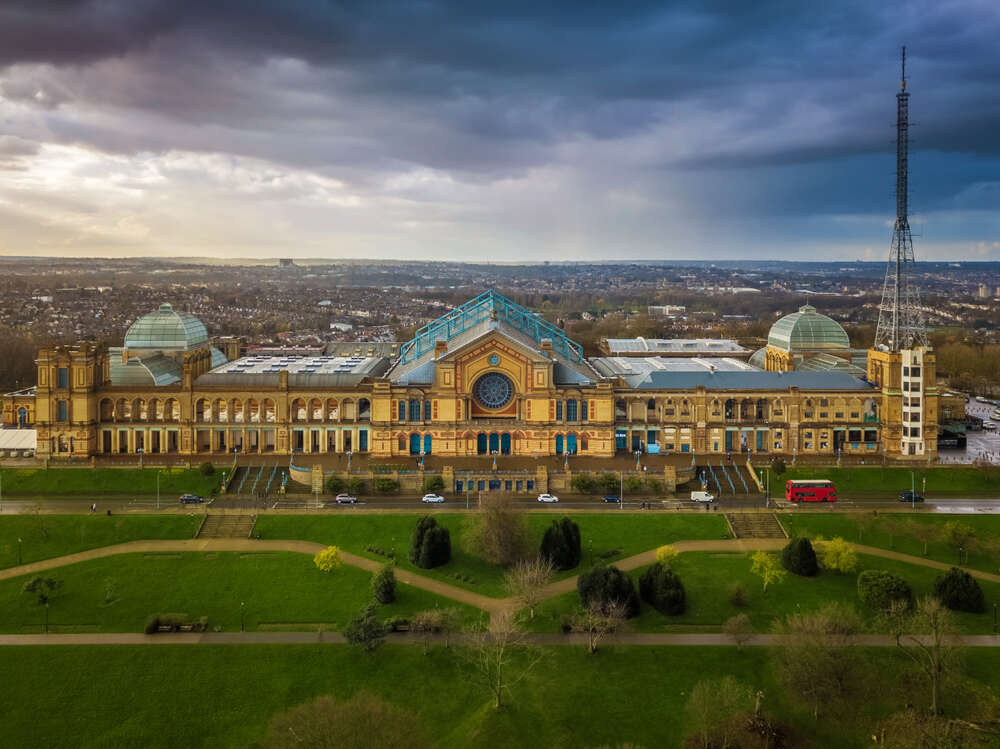
Alexandra Palace and Park aren’t the former home of some forgotten bit of the nobility: they were actually purpose-built for more or less their current use, as a venue for north Londoners to get up to a wide variety of things that may or may not be considered fun.

Various Victorians, including Owen Jones (presumably not him), one of the architects responsible for the Crystal Palace in the south, thought an equivalent in the north might be worthwhile, and used the same cost-saving manoeuvre: while the Crystal Palace had been built from the construction materials of the Great Exhibition, it’s northern counterpart used parts from the 1862 International Exhibition in Kensington.
Initially known as “the Palace of the People”, it took on a marginal air of aristocracy when the park opened in 1863, the same year that the future King Edward VII married Alexandra of Denmark. The building opened in 1873, and copied Crystal Palace again, albeit preemptively, by almost immediately burning to the ground.
Alexandra Palace: what is it good for?
But two years later they’d nailed the bits back together and finally, the people of north London had something to do other than complaining how long it’s going to take them to get to a birthday party in Peckham.
One of the more notable features of the next century or so of the park’s existence was its racecourse, known as The Frying Pan because it looked a bit like a frying pan on whatever the Victorian equivalent of satellite photography is (balloon rides or imagining things, I guess). Popular for much of its life, attendance dwindled in the 1970s. Who wants to look at horses when television’s in colour now?
It was the favourite course of John McCririck – he’d been linked to efforts to get it rebuilt and had instructed his wife to scatter his ashes on the site. Hopefully, local residents will be warned so they can shut their windows first. Though the outline of the course is visible from above – the cricket pitch sits in the middle of it – it otherwise only survives in the names of a couple of now-trendified gastro-pubs, the Victoria Stakes and the Starting Gate.
Early non-horse-based physical activities available included going up in a balloon (mainly to draw pictures of what the race course looked like, presumably) and then jumping off the balloon while wearing a parachute if you were, for example, the waitress turned daredevil Dolly Shepherd, commemorated in a mural on the side of the palace. There was also a lido, which legend states was used to wash visiting circus elephants. It is unclear whether this is connected to the dubious cleanliness that to its demise by the early part of the last century.
Winter sports have been an unlikely intermittent feature of the park: you prod some of the undergrowth on one side of the hill, you might be able to uncover the remains of what was once London’s most popular dry ski slope, ideal for if you didn’t want to have to lie to all your friends about how much fun your first skiing holiday had been. Though long since defunct, in 1990 it gained a spiritual successor in the palace’s ice rink, which among other things has been home to various ice hockey teams, most recently the ‘Haringey Huskies’.
However, back in the 1980s the palace and park were briefly threatened with being entirely sport-based. After the palace decided to have a belated centenary celebration and burn down again, there was a proposal to redevelop the whole thing into a massive sports complex, including – good news, snow haters – a brand new dry ski slope. In the end, nothing came of it – the existing building was retained and most of the sport associated with the park now is of the indoor variety: among many other things, the palace hosts darts and table tennis tournaments.
The park does see a bit of the action. Aside from the football and cricket pitches, a popular brand of energising drink sponsors a soapbox race, and there’s a miniature golf course that makes up for being golf by a) being miniature and b) allowing you to drink while playing (well, if you book the whole thing for an office party circa 2011).
[Read more: A brief history of Vauxhall Pleasure Gardens]






